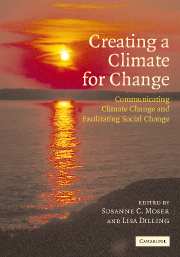Book contents
- Frontmatter
- Contents
- Preface
- Foreword
- List of contributors
- List of tables
- List of figures
- List of text boxes
- Introduction
- Part I Communicating climate change
- Part II Facilitating social change
- 15 Stuck in the slow lane of behavior change? A not-so-superhuman perspective on getting out of our cars
- 16 Consumption behavior and narratives about the good life
- 17 Educating for “intelligent environmental action” in an age of global warming
- 18 Education for global responsibility
- 19 Changing the world one household at a time: Portland's 30-day program to lose 5,000 pounds
- 20 Changing organizational ethics and practices toward climate and environment
- 21 Change in the marketplace: business leadership and communication
- 22 The market as messenger: sending the right signals
- 23 Making it easy: establishing energy efficiency and renewable energy as routine best practice
- 24 Forming networks, enabling leaders, financing action: the Cities for Climate Protection™ campaign
- 25 Ending the piecemeal approach: Santa Monica's comprehensive plan for sustainability
- 26 States leading the way on climate change action: the view from the Northeast
- 27 West Coast Governors' Global Warming Initiative: using regional partnerships to coordinate climate action
- 28 Building social movements
- 29 Climate litigation: shaping public policy and stimulating debate
- 30 The moral and political challenges of climate change
- Part III Creating a climate for change
- About the authors
- Index
- References
22 - The market as messenger: sending the right signals
Published online by Cambridge University Press: 20 August 2009
- Frontmatter
- Contents
- Preface
- Foreword
- List of contributors
- List of tables
- List of figures
- List of text boxes
- Introduction
- Part I Communicating climate change
- Part II Facilitating social change
- 15 Stuck in the slow lane of behavior change? A not-so-superhuman perspective on getting out of our cars
- 16 Consumption behavior and narratives about the good life
- 17 Educating for “intelligent environmental action” in an age of global warming
- 18 Education for global responsibility
- 19 Changing the world one household at a time: Portland's 30-day program to lose 5,000 pounds
- 20 Changing organizational ethics and practices toward climate and environment
- 21 Change in the marketplace: business leadership and communication
- 22 The market as messenger: sending the right signals
- 23 Making it easy: establishing energy efficiency and renewable energy as routine best practice
- 24 Forming networks, enabling leaders, financing action: the Cities for Climate Protection™ campaign
- 25 Ending the piecemeal approach: Santa Monica's comprehensive plan for sustainability
- 26 States leading the way on climate change action: the view from the Northeast
- 27 West Coast Governors' Global Warming Initiative: using regional partnerships to coordinate climate action
- 28 Building social movements
- 29 Climate litigation: shaping public policy and stimulating debate
- 30 The moral and political challenges of climate change
- Part III Creating a climate for change
- About the authors
- Index
- References
Summary
Introduction
At first blush, a chapter on economic and fiscal tools would seem to be out of place in a book about communicating climate change. And yet, markets and prices are essentially little more than structures which exchange information about what we value, and how much we value it. As Nobel prize-winning economist Kenneth Arrow put it, markets “can be viewed as information and decision structures in which communication takes the form of prices.…[P]rices … according to the pure theory, are normally the only communication that needs to be made” (cited in Babe, 1996).
For many economists, prices effectively communicate value automatically and most attempts to intercede in this self-organizing system are usually perceived as ill conceived and counterproductive because they interfere with the operation of Adam Smith's “invisible hand.” This theory holds that relatively unconstrained markets allocate wealth more efficiently than would any top–down attempt to manage markets. Economists have long recognized, however, that many market exchanges leave out a great deal of information. British political economist A. C. Pigou, writing in the 1920s, noted that smoke from a factory, for example, imposed costs on third parties that were not reflected in exchange prices (Pigou, 1932). These unaccounted costs could be conceived of as information failures; economists call them “externalities.”
For the most part, economists have used two devices to improve price signals so that they more accurately include information and value that are normally left out of market exchanges.
- Type
- Chapter
- Information
- Creating a Climate for ChangeCommunicating Climate Change and Facilitating Social Change, pp. 339 - 358Publisher: Cambridge University PressPrint publication year: 2007
References
- 1
- Cited by

